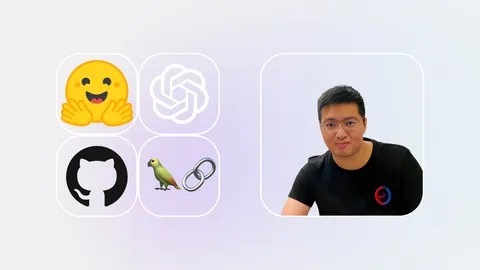Becoming An Ai Engineer With Llm Application Development
Published 8/2024
MP4 | Video: h264, 1920x1080 | Audio: AAC, 44.1 KHz
Language: English | Size: 816.52 MB | Duration: 1h 46m
Published 8/2024
MP4 | Video: h264, 1920x1080 | Audio: AAC, 44.1 KHz
Language: English | Size: 816.52 MB | Duration: 1h 46m
A concise guide for AI engineers to develop and deploy LLM-powered applications
What you'll learn
Learn the fundamental of LLM and generative AI
Learn the fundamental of API development
Learn the fundamental of Gradio framework
Develop your own AI chatbot in a day
Deploy your solution with Hugging Face Space
Automate your application development and deployment workflow to improve software quality and delivery speed
Requirements
Passion for AI
Computer (MacOS, Linux, or Windows)
Stable Network Connection
Python Installed - Recommended version: 3.9 or 3.10
Visual Studio Code Installed
Hugging Face Pro Subscription
OpenAI API Subscription
GitHub Account (Free or Pro)
Description
Becoming an AI Engineer with LLM Application Development| A concise guide for AI engineers to develop and deploy generative AI applications |What is generative AI? Why you should be a part of this revolution?Generative AI is a truly transformative technology that allows us to engineer and deploy various AI applications like chatbots and other automation workflows without costly upfront investments. Therefore, there is an emerging trend that many companies, even if not within the technology domains like finance and health care, are trying to adopt AI applications like ChatGPT. Here is what an AI engineer could do to help these organizations develop and deploy a valuable and cost-effective AI application using various open or closed-source models. If you want to be a part of this revolution, this course is right for you to learn the fundamental concepts and practical skills to become an AI engineer nowadays.What can I learn from this course?- Chapter 1 - Introduction to Generative AI- Chapter 2 - Environment Set-up / Generative AI Platform Tours- Chapter 3 - Develop your API endpoint for your generative AI applications- Chapter 4 - Develop and Deploy with your Front-end Interface- Chapter 5 - Streamline API Delivery with Automated Test and Deployment Pipeline- Chapter 6 - Course Summary / Final ExamWhat can I gain from this course?This course has a wide range of materials to help you become familiar with the concepts and skills to design, develop, and deploy an AI application; those resources include:1. On-demand lecture videos2. Supplement learning resources to keep up to date with the latest trend3. Open-source codebase to help you kick-start your AI engineer journey4. Various online quizzes to help you familiarize yourself with the contents and the skills5. Q&A with the instructor6. Programming test with hands-on online practiceWho is my instructor?Mark is an entrepreneur and computer science student at the University of London who lives in Taiwan. He founded Mindify AI, a company aimed at helping software engineers learn new codebases faster with its flagship product, Mindify Chat. Mark is also involved in AI and quantum AI research, working on innovative projects, including utility-scale quantum generative AI models for the Google Quantum Application XPRIZE. In addition to his business ventures, Mark creates Notion templates and Udemy courses, generating side income. Mark's recent achievements include developing algorithms, leading research projects, starting a new company, and gaining traction for Mindify AI. He is dedicated to making his products profitable and advancing his research and business efforts.
Overview
Section 1: Chapter 1 - Introduction to Generative AI
Lecture 1 Course Overview
Lecture 2 What is artificial intelligence (AI)?
Lecture 3 What is generative AI (GenAI)?
Lecture 4 What are large-language models (LLMs)?
Lecture 5 What is prompt engineering?
Lecture 6 What is application programming interface (API)?
Lecture 7 What is LangChain?
Lecture 8 Supplement Materials
Section 2: Chapter 2 - Environment Set-up / Generative AI Platform Tours
Lecture 9 Python Environment Set-up
Lecture 10 Visual Studio Code Set-up
Lecture 11 GitHub Tour
Lecture 12 Hugging Face Tour
Lecture 13 OpenAI API Platform Tour
Lecture 14 Supplement Materials
Section 3: Chapter 3 - Develop your API for your generative AI applications
Lecture 15 What are HTTP and REST API?
Lecture 16 API development and deployment workflow
Lecture 17 Architecting your API backend application with FastAPI
Lecture 18 Demonstration - Architecting your FastAPI Applications
Lecture 19 Python API development with FastAPI
Lecture 20 Containerize your API application with Docker
Lecture 21 Deploying your API with Hugging Face Space
Section 4: Chapter 4 - Develop and Deploy with your Front-end Interface
Lecture 22 Introduction to Gradio and develop your first application
Lecture 23 Demonstration: Deploy your first Gradio application
Section 5: Chapter 5 - Streamline API Delivery with Automated Test Pipeline
Lecture 24 What is DevOps?
Lecture 25 What is software testing?
Lecture 26 Introduction to Pytest and Software Testing Frameworks
Lecture 27 Demonstration - Pytest for Generative AI Applications
Lecture 28 Demonstration - Automated Test Workflow with GitHub Actions
Section 6: Chapter 6 - Course Summary / Advanced Topics
Lecture 29 What is domain-adaptation?
Lecture 30 What is retrieval-augmented generation (RAG)?
Lecture 31 Course Recap
Lecture 32 Future Learning
Professional software developers who are new to generative AI application development,Computer science students who are interested in generative AI application development,Web developers who is seeking to build an generative AI as a side project,Python developers who is seeking to build an generative AI as a side project



